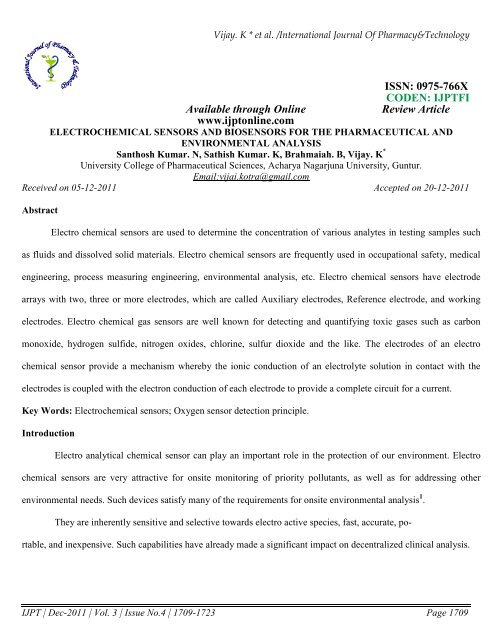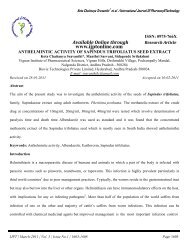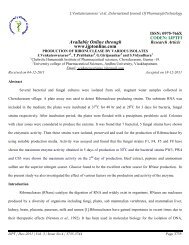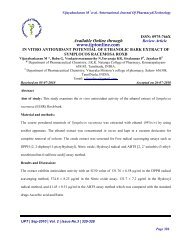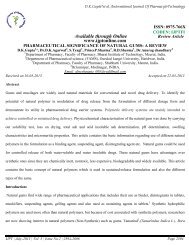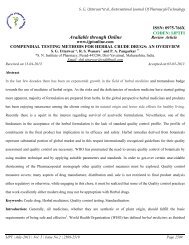ISSN: 0975-766X CODEN: IJPTFI Available through Online Review ...
ISSN: 0975-766X CODEN: IJPTFI Available through Online Review ...
ISSN: 0975-766X CODEN: IJPTFI Available through Online Review ...
- No tags were found...
You also want an ePaper? Increase the reach of your titles
YUMPU automatically turns print PDFs into web optimized ePapers that Google loves.
Vijay. K * et al. /International Journal Of Pharmacy&Technology<strong>ISSN</strong>: <strong>0975</strong>-<strong>766X</strong><strong>CODEN</strong>: <strong>IJPTFI</strong><strong>Available</strong> <strong>through</strong> <strong>Online</strong><strong>Review</strong> Articlewww.ijptonline.comELECTROCHEMICAL SENSORS AND BIOSENSORS FOR THE PHARMACEUTICAL ANDENVIRONMENTAL ANALYSISSanthosh Kumar. N, Sathish Kumar. K, Brahmaiah. B, Vijay. K *University College of Pharmaceutical Sciences, Acharya Nagarjuna University, Guntur.Email:vijai.kotra@gmail.comReceived on 05-12-2011 Accepted on 20-12-2011AbstractElectro chemical sensors are used to determine the concentration of various analytes in testing samples suchas fluids and dissolved solid materials. Electro chemical sensors are frequently used in occupational safety, medicalengineering, process measuring engineering, environmental analysis, etc. Electro chemical sensors have electrodearrays with two, three or more electrodes, which are called Auxiliary electrodes, Reference electrode, and workingelectrodes. Electro chemical gas sensors are well known for detecting and quantifying toxic gases such as carbonmonoxide, hydrogen sulfide, nitrogen oxides, chlorine, sulfur dioxide and the like. The electrodes of an electrochemical sensor provide a mechanism whereby the ionic conduction of an electrolyte solution in contact with theelectrodes is coupled with the electron conduction of each electrode to provide a complete circuit for a current.Key Words: Electrochemical sensors; Oxygen sensor detection principle.IntroductionElectro analytical chemical sensor can play an important role in the protection of our environment. Electrochemical sensors are very attractive for onsite monitoring of priority pollutants, as well as for addressing otherenvironmental needs. Such devices satisfy many of the requirements for onsite environmental analysis 1 .They are inherently sensitive and selective towards electro active species, fast, accurate, portable,and inexpensive. Such capabilities have already made a significant impact on decentralized clinical analysis.IJPT | Dec-2011 | Vol. 3 | Issue No.4 | 1709-1723 Page 1709
CharacteristicsVijay. K * et al. /International Journal Of Pharmacy&TechnologyThere are different ways that electrochemical sensors are constructed, depending both on the gas to bedetected as well as the manufacturer. However, the main characteristics of the sensors are essentially very similar.Following are some of the common characteristics 1 of electrochemical sensors.Electrolyte within the sensor cell is an aqueous solution separated by a hydrophobic barrier which will notallow the aqueous solution to leak out. However, water vapor can pass <strong>through</strong>, just as other gas molecules can. Inhigh humidity conditions, prolonged exposure can cause excessive water to build up and create leakage. In lowhumidity conditions, the sensor can dry out. Sensors that are designed to monitor high gas concentrations have lessporous barriers to limit the amount of gas molecules that pass <strong>through</strong>, and therefore are not affected bythe humidity as much as sensors that are used to monitor low gas concentrations, which have more porous barriersand allow a more free exchange of water molecules.Pressure and Temperature:In general, when the temperature is above 25°C, the sensor will read higher, when it is below 25°C, it willread lower. The temperature effect is typically 0.5% to 1.0% per degree centigrade, depending on the manufacturerand type of sensor.Selectivity:Electrochemical sensors are generally fairly selective to the target gas they are designed for. The degree ofselectivity depends on the type of sensor, the target gas, and the concentration of gas the sensor is designed to detect.Life Expectancy:The life expectancy of an electrochemical sensor depends on several factors, including the gas to be detectedand the environmental conditions in which the sensor is used. In reality, the life expectancy will be highly dependenton the total amount of gas exposed to the sensor during its life, as well as other environmental conditions, such astemperature, pressure and humidity. Typical gases and the rangea of measurements of electrochemical sensors areshown in table 1.IJPT | Dec-2011 | Vol. 3 | Issue No.4 | 1709-1723 Page 1710
Vijay. K * et al. /International Journal Of Pharmacy&TechnologyTable 1. Typical gases and the Range of Measurements of Electrochemical Sensors.GAS NAMEPPM RANGEAmmonia NH 3 10Arsinic Hydrochloride, ArH 3 1Bromin, Br 2 30Chlorine dioxide, Clo 2 5Hydrogen H 2 2000Major ComponentsAn electrochemical sensor consists of the following major components 1 :Gas Permeable Membrane (hydrophobic membrane):This is used to cover the sensor’s sensing (catalyst) electrode and, in some instances, to control the amount ofgas molecules reaching the electrode surface. Such barriers are typically made of thin, low-porosity Teflonmembranes. Such sensors are called membrane clad sensors. Alternatively, the sensing electrode is covered with ahigh-porosity Teflon and the amount of gas molecules reaching the electrode surface is controlled by a capillary.Such sensors are referred to as capillary-type sensors. Besides offering a mechanical protection to the sensor, themembrane performs the additional function of filtering out unwanted particulates. Selecting the correct pore size ofthe membrane and capillary is necessary to transfer the proper amount of gas molecules. The pore size should be suchas to allow enough gas molecules to reach the sensing electrode. The pore size should also prevent liquid electrolytefrom leaking out or drying out the sensor too quickly.Electrode:The selection of the electrode material is very important. It is a catalyzed material which performs the half cellreaction over a long period of time. Typically, the electrode is made from a noble metal, such as platinum or gold,and catalyzed for an effective reaction with gas molecules. Depending on the design of the sensor, all three electrodescan be made of different materials to complete the cell reaction.IJPT | Dec-2011 | Vol. 3 | Issue No.4 | 1709-1723 Page 1711
Electrolyte:Vijay. K * et al. /International Journal Of Pharmacy&TechnologyThe electrolyte must facilitate the cell reaction and carry the ionic charge across the electrodes efficiently. Itmust also form a stable reference potential with the reference electrode and be compatible with materials used withinthe sensor. If the electrolyte evaporates too quickly, the sensor’s signal will deteriorate.Filter:Sometimes a scrubber filter is installed in front of the sensor to filter out unwanted gases. There is a limitedselection of filters, each with different degrees of effectiveness. The most commonly used filter medium is activatedcharcoal. The activated Char coal filters out most chemicals with the exception of carbon monoxide and hydrogengases. By properly selecting the filter medium, an electrochemical sensor can be made more selective to its targetgases. Choosing the suitable materials for the above components, and arranging the geometry of all these componentsto determine the optimum operating performance presents a challenge to scientists. Minor variations in the details ofthe sensor design can have a profound influence on the sensor’s accuracy, response time, sensitivity, selectivity, andlife expectancy.Principle of OperationElectro chemical sensors operate by reacting with the gas of interest and producing an electrical signalproportional to the gas concentration 1 . A typical electrochemical sensor consists of a sensing electrode (or workingelectrode), and a counter electrode separated by a thin layer of electrolyte.Fig.1. Block diagram of electrochemical sensorIJPT | Dec-2011 | Vol. 3 | Issue No.4 | 1709-1723 Page 1712
Vijay. K * et al. /International Journal Of Pharmacy&TechnologyGas that comes in contact with the sensor first passes <strong>through</strong> a small capillary-type opening and then diffuses<strong>through</strong> a hydrophobic barrier, and eventually reaches the electrode surface. This approach is adopted to allow theproper amount of gas to react at the sensing electrode to produce a sufficient electrical signal while preventing theelectrolyte from leaking out of the sensor, fig.1. The gas that diffuses <strong>through</strong> the barrier reacts at the surface of thesensing electrode involving either an oxidation or reduction mechanism. These reactions are catalyzed by theelectrode materials specifically developed for the gas of interest. With a resistor connected across the electrodes, acurrent proportional to the gas concentration flows between the anode and the cathode. The current can be measuredto determine the gas concentration. Because a current is generated in the process, the electrochemical sensor is oftendescribed as an amperometric gas sensor or a micro fuel cell.Fig.2. Diffusion <strong>through</strong> hydrophobic membrane.PRINCIPLES INVOLVED IN DIFFERENT TYPES OF ELECTROCHEMICAL SENSORS:1. OXYGEN SENSOR DETECTION PRINCIPLE:Most portable or survey instruments used for workplace evaluation of oxygen concentrat-ions make use of"fuel cell" type oxygen sensors. "Fuel cell" oxygen sensors consist of a diffusionbarrier, a sensing electrode (cathode) made of a noble metal such as gold or platinum, and a workingelectrode made of a base metal such as lead or zinc immersed in a basic electrolyte(such as a solution of potassium hydroxide) 1 . Oxygen diffusing into the sensor is reduced to hydroxyl ions at the cathode. Hydroxyl ions in turnoxidize the lead (or zinc) anode.IJPT | Dec-2011 | Vol. 3 | Issue No.4 | 1709-1723 Page 1713
This yields an overall cell reaction of:Vijay. K * et al. /International Journal Of Pharmacy&Technology2Pb + 4 OH 2PbO + 2H 2 O + 4e -2Pb + O 22 PbOFuel cell oxygen sensors are current generators. The amount of current generated is proportional to theamount of oxygen consumed (Faraday's Law). Oxygen reading instruments simply monitor the current output of thesensor. An important consideration is that fuel cell oxygen sensors are used up over time. In the cell reaction above,when all available surface area of the lead (Pb) anode has been converted to lead oxide (PbO), electrochemicalactivity ceases, current output falls to zero, and the sensor must be rebuilt or replaced. Fuel cell sensors are designedto last no more than one to two years. Even when installed in an instrument which is never turned on, oxygen sensorswhich are exposed to atmosphere which contains oxygen are generating current, and beingused up. Oxygen sensors are also influenced by the temperature of the atmosphere and are being useto measure. Thewarmer the atmosphere, the faster the electrochemical reaction.For this reason oxygen sensors usually include a temperature compensating load resistor to hold currentoutput steady in the face of fluctuating temperature. Another limiting factor is cold. The freezing temperatureof electrolyte mixtures commonly used in oxygen sensors tends to be about 5 o F (- 20 o C). Once the electrolyte hasfrozen solid, electrical output falls to zero, and readings may no longer be obtained. There are two basic variations onthe fuel cell oxygen sensor design. These variations have to do with the mechanism by which oxygen is allowed todiffuse into the sensor. Dalton's Law states that the total pressure exerted by a mixture of gases is equal to the sum ofthe partial pressures of the various gases. The partial pressure for oxygen is that fraction of the total pressure due tooxygen. Partial atmospheric pressure oxygen sensors rely on the partial pressure (or pO 2 ) of oxygen to drivemolecules <strong>through</strong> the diffusion barrier into the sensor.As long as the pO 2 remains constant, current output may be used to indicate oxygen concentration. On theother hand, shifts in barometric pressure, altitude, or other conditions which have an effect on atmospheric pressurewill have a strong effect on pO 2 sensor readings. Since there is less force driving oxygen molecules <strong>through</strong> theIJPT | Dec-2011 | Vol. 3 | Issue No.4 | 1709-1723 Page 1714
Vijay. K * et al. /International Journal Of Pharmacy&Technologydiffusion barrier into the sensor, the current output is significantly lower. "Capillary pore" oxygen sensor designsinclude a narrow diameter tube <strong>through</strong> which oxygen diffuses into the sensor. Oxygen is drawn into the sensor bycapillary action in much the same way that water or fluid is drawn up into the fibers of a paper towel. While capillarypore sensors are not influenced by changes in pressure, care must be taken that the sensor design includes a moisturebarrier in order to prevent the pore from being plugged with water or other fluids.2. EFFECTS OF CONTAMINANTS ON OXYGEN SENSORS:Fig. 3. Capillary pore oxygen sensorOxygen sensors may be affected by prolonged exposure to "acid" gases such measured in many cases to 0.1ppm. The chief limitation of electrochemical sensors is the effects of interfering contaminants on toxic gas readings.Most substance-specific electrochemical sensors have been carefully designed to minimize the effects of commoninterfering gases. Substance-specific sensors are designed to respond only to the gases they are supposed to measure.The higher the specificity of the sensor the less likely the sensor will be affected by exposure to other gases whichmay be incidentally present. For instance, a substance-specific carbon monoxide sensor is deliberately designed not torespond to other gases which may be present at the same time, such as hydrogen sulfide or methane. Even thoughcare has been taken to reduce cross-sensitivity, some interfering gases may still have an effect on toxic sensorreadings. In some cases the interfering effect may be "positive" and result in readings which are higher than actual. Insome cases the interference may be negative and produce readings which are lower than actual. Electrochemicalsensor designs may include a selective external filter designed to remove interfering gases which would otherwisehave an effect on the sensing electrode. The size and composition of the filter are determined by the type andexpected concentration of the interfering contaminants being removed. Depending on the nature of the reaction eachIJPT | Dec-2011 | Vol. 3 | Issue No.4 | 1709-1723 Page 1715
Vijay. K * et al. /International Journal Of Pharmacy&Technologygas has with the sensor, the effect can either decrease the signal (negative cross sensitivity) or increase the signal(positive cross sensitivity). Most oxygen sensors are not recommended for continuous use in atmospheres whichcontain more than 25% CO 2 .3. SUBSTANCE-SPECIFIC ELECTROCHEMICAL SENSORS:One of the most useful detection techniques for toxic contaminants is the use of substance specificelectrochemical sensors installed in compact, field portable survey instruments. Substance-specific electrochemicalsensors consist of a diffusion barrier which is porous to gas but nonporous to liquid, reservoir of acid electrolyte(usually sulfuric or phosphoric acid), sensing electrode, counter electrode, and (in three electrode designs) a thirdreference electrode. Gas diffusing into the sensor reacts at the surface of the sensing electrode. The sensing electrodeis made to catalyze a specific reaction. Dependent on the sensor and the gas being measured, gas diffusing into thesensor is either oxidized or reduced at the surface of the sensing electrode. This reaction causes the potential of thesensing electrode to rise or fall with respect to the counter electrode. The current generated is proportional to theamount of reactant gas present. This two electrode detection principle presupposes that the potential of the counterelectrode remains constant. In reality, the surface reactions at each electrode causes them to polarize, andsignificantly limits the concentrations of reactant gas they can be used to measure. In three electrode designs it is thedifference between the sensing and reference electrode.Fig. 4. Substance specific electrochemical sensor.IJPT | Dec-2011 | Vol. 3 | Issue No.4 | 1709-1723 Page 1716
Vijay. K * et al. /International Journal Of Pharmacy&Technologymechanism:The oxidation of carbon monoxide in an electrochemical sensor provides a good example of the detectionCarbon monoxide is oxidized at the sensing electrode:CO 2 + H 2 O H 2 CO 3The counter electrode acts to balance out the reaction at the sensing electrode by reducing oxygen present inthe air to water:1/2 O 2 + 2H + + 2e _ H 2 OSimilar reactions allow for the electrochemical detection of a variety of reactant gases including hydrogensulfide, sulfur dioxide, chlorine, hydrogen cyanide, nitrogen dioxide, hydrogen, ethylene oxide, phosphine and ozone.A bias voltage is sometimes applied to the counter electrode to help drive the detection reaction for a specificcontaminant. Biased sensor designs allow for the detection of a number of less electrochemically active gases such ashydrogen chloride and nitric oxide. Several other contaminants (such as ammonia) are detectable by means of otherless straight forward detection reactions.In some cases, cross sensitivity is used to deliberate advantage. Carbon monoxide and hydrogen sulfide arethe two most common toxic gases associated with confined space entry. In addition to "substance specific" sensorsdesigned to measure these toxic hazards, several manufacturers offer a dual purpose sensor designed to detect bothcarbon monoxide and hydrogen sulfide. Dual purpose sensors of this kind are useful in situations requiring use of asingle sensor to monitor simultaneously for both toxic hazards. It should be pointed out that since dual purposesensors have been designed to respond to both hazards at the same time, they cannot determine which of the twohazards is producing the reading. A dual purpose sensor cannot determine which hazard is present in what specificconcentrations, but may still be capable of providing an immediate indication when conditions become unsafe. Whena specific contaminant such as hydrogen sulfide is known to be potentially present, the best approach is usually to usea direct reading substance specific sensor.IJPT | Dec-2011 | Vol. 3 | Issue No.4 | 1709-1723 Page 1717
Vijay. K * et al. /International Journal Of Pharmacy&Technology4. METAL OXIDE SEMICONDUCTOR SENSORS:Metal oxide semiconductor (or MOS) sensors may be used for toxic as well as combustible gas monitoring.As discussed previously in the combustible gas monitoring section, MOS sensing elements consist of a metal oxidesemiconductor such as tin dioxide (SnO 2 ) on a sintered alumina ceramic bead contained within a flame arrestor. Inclean air the electrical conductivity is low, while contact with reducing gases such as carbon monoxide orcombustible gases increases conductivity. Sensitivity of the sensing element to a particular gas may be altered bychanging the temperature of the sensing element.Fig. 5. Metal oxide semiconductor sensorMOS sensors are "broad range" devices designed to respond to the widest possible range of toxic andcombustible gases, including chlorinated solvent vapors and other contaminants difficult to detect by other means.This non specificity can be advantageous in situations where unknown toxic gases may be present and a simple go orno go determination of the presence of toxic contaminants is sufficient. Since sensitivity of the sensing element to aparticular gas is mathematically predictable, a commonly used strategy is to preprogram the instrument with anumber of theoretical specific response curves. If the exact nature of the contaminant is known, an identification codecan be entered, and readings of the sensor will be adjusted to reflect the expected sensitivity of the sensor to thecontaminant being measured. MOS sensors offer the ability to detect low (0 - 100 ppm) concentrations of toxic gasesover a wide temperature range. The chief limitations concerning use of this kind of sensor are the difficulty in theinterpretation of positive readings, the potential for false positive alarms, and the effects of humidity on sensor output.IJPT | Dec-2011 | Vol. 3 | Issue No.4 | 1709-1723 Page 1718
Vijay. K * et al. /International Journal Of Pharmacy&TechnologyAs humidity increases sensor output increases as well. As humidity drops to very low levels, sensor output may fall tozero even in the presence of gas. In addition if a user keys in the preprogrammed response curve for a contaminantwhich is highly detectable by the sensor, but actually encounters one which is less detectable, the result may beerroneously low readings.MechanismElectrochemical sensors are the largest group of chemical sensors, representing approximately 58% of thetotal chemical sensors. Other types include optical (24%), mass (12%) and thermal (6%). This division is based onthe general transduction principle, general mechanism involved in this electrochemical sensor is Transductionmechanism 2 . Electrochemical sensors are devices that extract information about sample from measurement of someelectrical parameters 3 . It is easy to categorize by measuring their electrical parameters, as they are linked together byOhms (i.e the potential difference in a circuit is equal to the product of the current and the resistance that is voltage =amphere time ohm). So, if we measure difference of two potentials we discus about potentiometric sensors.APPLICATIONS OF ELECTROCHEMICAL SENSORS ON CLINICAL ANALYSIS:1. METABOLITES:(a) Cholesterol:-Determination of the cholesterol level in human blood is of great significance in clinical analysis/diagnosis.High cholesterol accumulation in blood serum is strongly correlated with coronary heart disease, arteriosclerosis,myocardial infarction, brain thrombosis, lipid metabolism dysfunction, hypertension, etc. 4 Cholesterol determinationis performed by enzymes, such as cholesterol oxidase (ChO x ) and cholesterol esterase. These together can be used tomonitor both native and esterified cholesterol levels. Cholesterol esterase catalyzes the hydrolysis of cholesterol ester,which is important for determination of total cholesterol. The estimation of cholesterol is based on follows:Cholesterol ester + H 2 0Cholesterol esterase Cholesterol + fatty acidsCholesterol + O 2Cholesterol oxidaseCholesterol 3 + H 2 O 2IJPT | Dec-2011 | Vol. 3 | Issue No.4 | 1709-1723 Page 1719
Vijay. K * et al. /International Journal Of Pharmacy&TechnologyThe production of hydrogen peroxide is oxidized at a high anodic potential (above +0.6 V) 5 . Some researchers usedhorseradish peroxidase (HRP) 6 or electron transfer mediators, such as ferrocyanide 7 , and Prussian Blue 8,9 , tomeasure hydrogen peroxide reduction current at lower potential and, thus, to avoid the influence of reductants.Nanostructures such as nano wires, nanoparticles and CNTs have been used as smart building blocks for emergingelectronic and sensing devices.(b) Uric acid:One of the major problems in biological determinations of UA comes from electrochemical interferences suchas ascorbic acid (AA), which has a similar oxidation potential, E1/2 ≈ 200 mV versus SCE, at graphite electrodes,and is present at high concentrations in biological systems 10 . Removing the interference caused by AA is critical inUA sensor design. There are two methods for the measurement of UA, enzymatic and non-enzymatic. The enzymaticprocedures using uricase (urate oxidase, EC 1.7.3.3, UOx), have been developed based on amperometric detection ofH 2 O 2 produced in the reaction below:Uric acid + O 2 + 2H 2 Ouricaseallantoin + H 2 O 2 + CO 2Other enzymatic procedures are based on electron transfer mediators, the reactions are as follows:uric acid + mediator (ox) + 2H 2 Ouricase allantoin + mediator (red) + CO 2 + 2H +mediator (red) mediator (ox) + 2 e -Much research into conducting polymer-based enzymatic sensors for detecting UA has been reported. In order toenhance the fixation and stability of UO x and electron transfer mediators on the surface of electrode, polypyrrole andits derivatives such as dodecyl sulfate dopedpoly(N-methylpyrrole) were utilized 11,12 .(c) Lactate:Reliable blood lactate measurements would also be of interest in sports medicine. Lactate can be measuredbased on the reaction using NAD + dependent lactate dehydrogenase and ferricyanide.lactate + NAD +lactate dehydrogenasepyruvate + NADHIJPT | Dec-2011 | Vol. 3 | Issue No.4 | 1709-1723 Page 1720
Vijay. K * et al. /International Journal Of Pharmacy&TechnologyNADH + 2Fe(CN) 3- 6diaphorase NAD + + 2Fe(CN) 4- 6 + H+2. Blood gases:Biological body consumes oxygen and release carbon dioxide by gaseous exchange in alveolus and tissue.Partial pressure of carbon dioxide (pCO 2 ) and partial pressure of oxygen (pO2) dominantly interact with physicalconditions. Particularly, pO 2 reflects lung stress such as pulmonary embolism or pulmonary atelectasis and it is anindicator of blood oxygen levels, which is used for diacrisis, treatment and management of depressed respiration 13 .3. Electrolytes:A miniaturized electrochemical simultaneous multisensor array for K + , Na + , and Ca +2 in human whole blood,based on chemical vapor deposition technique, had been tested . This sensor array was composed of a four channelportable battery operated, reference electrode and simultaneous multi-sensing electronic system based on discreteelectronic parts 14 . A ion-selective planar sensor for K+ and Ca2+, which was fabricated with bulk siliconmicromachining techniques using a double-sided wafer process combined with polymeric membrane coatings, andthe dimension of the chip is 1 mm × 5 mm × 0.5 mm. This potentiometric device had solid-state contacts and uses ahydrogel as an inner liquid electrolyte solution 15 . The sensors showed near Nernstian slope, good resolution,sufficient lifetime, and excellent reliability, but a larger drift, mainly in the start-up period.4. DNA:Deoxyribonucleic acid (DNA) is a very important biomolecule that has an essential role in the determinationof hereditary characteristics, storing the genetic information necessary for the replication of living organisms 16 . DNAanalysis is the most recent and most promising application of electrochemical sensors to clinical chemistry.5. Other analyses:These are also used for the measurement of Haemoglobin, Blood ketones (Ketone bodies, including β-hydroxybutyrate, acetoacetic acid and acetone, are produced by incomplete fatty acid metabolism withinmitochondria of hepatocytes) and Nitric oxide (An electrochemical device for detecting exhaled NO based on aspecially designed electrochemical sensor was developed).IJPT | Dec-2011 | Vol. 3 | Issue No.4 | 1709-1723 Page 1721
ReferencesVijay. K * et al. /International Journal Of Pharmacy&Technology1. http:// www.intlsensor.com/pdf/electrochemical.pdf.2. Li G, Ma. N.Z, Wang. Y, A new handheld biosensor for monitoring blood ketones., Sens. Actuators. B. Chem.2005, Vol.109, pp-285-290.3. Forrow. N.J, Sanghera. G.S, Walters. S.J, Watkin. J.L, Development of a commercial amperometric biosensorelectrode for the ketone D-3-hydroxybutyrate., Biosens. Bioelectron., 2005, Vol.20, pp-1617-1625.4. Fredrickson. D.S, Levy. R.I, The metabolic basis of inherited disease., Stanbury, 1972, pp- 545..5. Aravamudhan. S, Kumar. A, Mohapatra. S, Bhansali. S, Sensitive estimation of total cholesterol in blood usingAu nanowires based micro-fluidic platform, Biosens. Bioelectron., 2007, Vol.22, pp-2289-2294.6. Bongiovanni. C, Ferri. T, Poscia. A, Varalli. M, Santucci. R, Desideri. A, An electrochemical multienzymaticbiosensor for determination of cholesterol, Bioelectrochemistry., 2001, Vol.54, pp-17-22.7. Li. G, Liao. J.M, Hu. G.Q, Ma. N.Z, Wu. P.J, Study of carbon nanotube modified biosensor for monitoringtotal cholesterol in blood, Biosens. Bioelectron., 2005, Vol.20, pp-2140-2144.8. Vidal. J.-C, Espuelas. J, Garcia-Ruiz. E, Castillo. J.-R, Amperometric cholesterol biosensors based on theelectropolymerization of pyrrole and the electrocatalytic effect of Prussian-Blue layers helped with selfassembledmonolayers, Talanta, 2004, Vol.64, pp-655-664.9. Li. J, Peng. T, Peng. Y, A Cholesterol Biosensor Based on Entrapment of Cholesterol Oxidase in a Silicic Sol-Gel Matrix at a Prussian Blue Modified Electrode, Electroanalysis, 2003, Vol.15, pp-1031-1037.10. Bravo. R, Hsueh. C, Jaramillo. A, Brajter-Toth. A, Possibilities and limitations in miniaturized sensor designfor uric acid, Analyst, 1998, Vol.123, pp-1625-1630.11. Dobay. R, Harsanyi. G, Visy. C, Detection of uric acid with a new type of conducting polymerbased enzymaticsensor by bipotentiostatic technique, Anal. Chim. Acta., 1999, Vol.385, pp-187-194.12. Cete. S, Yasar. A, Arslan. F, An amperometric biosensor for uric acid determination prepared from uricaseimmobilized in polypyrrole film, Artif. Cells, Blood Subst. Biotechnol., 2006, Vol.34, pp-367-380.IJPT | Dec-2011 | Vol. 3 | Issue No.4 | 1709-1723 Page 1722
Vijay. K * et al. /International Journal Of Pharmacy&Technology13. Kudo. H, Iguchi. S, Yamada. T, Kawase. T, Saito. H, Otsuka. K, Mitsubayashi. K, A flexible transcutaneousoxygen sensor using polymer membranes, Biomed. Microdevices., 2007, Vol.9, pp-1-6.14. Lauks. I.R, Microfabricated Biosensors and Microanalytical Systems for Blood Analysis, Acc. Chem. Res.,1998, Vol.31, pp-317-324.15. Akagi. Y, Makimura. M, Yokoyama. Y, Fukazawa. M, Fujiki. S, Kadosaki. M, Tanino. K, Development of aligation-based impedimetric DNA sensor for single-nucleotide polymorphism associated with metabolicsyndrome, Electrochim. Acta., 2006, Vol.51, pp-6367-6372.16. Li. X.-M, Ju. H.-Q, Du. L.-P, Zhang. S.-S, A nucleic acid biosensor for the detection of a short sequencerelated to the hepatitis B virus using bis(benzimidazole)cadmium(II) dinitrate as an electrochemical indicator,J. Inorg. Biochem., 2007, Vol.101, pp-1165-1171.Corresponding Author:Vijay. K *Email:vijai.kotra@gmail.comIJPT | Dec-2011 | Vol. 3 | Issue No.4 | 1709-1723 Page 1723


